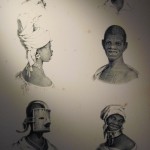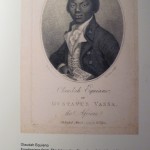September 15th, 2009 · No Comments
-
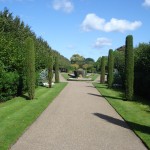
-
Regents Park
-
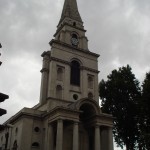
-
Christ’s Church
-
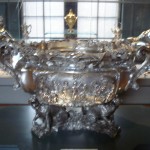
-
The Silver Exhibit in the V&A
-
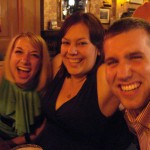
-
Having a Good Time at the Fitzroy
Like many of my classmates I decided it would be worthwhile to summarize all of my discoveries this month in London. During this post I will focus on six main themes found within London: Parks, Churches, Pubs, Other Religious Institutions, Theatre and Museums.
Parks
Each park that I visited had its own distinct characteristics that separated it from any other. Green Park was the first I visited and after perusing a few others, I realized there was nothing that exciting about it. Located right across from Buckingham Palace, Green Park certainly provides a good place to go and take a break from the busy atmosphere of the area. Besides this however there is not much going on and I would recommend that potential park goers walk the extra distance over to St. James Park.
In addition to the large number of waterfowl heckling people for food which offers consistent entertainment St. James offers some picturesque flower beds throughout and various monuments along the way. It has the relaxing atmosphere of Green Park with a bit more excitement sprinkled in.
Regents Park offers a completely different feel from Green or St. James. Located in a separate area of London, Regents Park has a history of being used by a higher end crowd. I could tell this immediately from the feel of the park. The decorative shrubbery and elegant architecture throughout gave me a feeling that Regents is not as well used as other parks.
Since I was one of the members of the Parks group that gave a walking tour of Hyde Park and Kensington Gardens I could go into a lot more detail about these two green spaces but I will choose not to in an effort to be concise. In summary Hyde Park is the largest green space in London and is often used for larger events such as concerts, festivals etc. It also contains a large number of monuments throughout including the 7/7 memorial and the Diana Memorial Fountain. Kensington Gardens is home to a variety of key monuments but is not as well trodden as Hyde. Overall it makes for a quieter atmosphere, more conducive fo reading or “snogging”.
Regents Park were my two favorite green spaces in London. Regents, is both beautiful, and extremely large and I continually felt the need to go back and explore. Kensington Gardens appealed to me in that it was quainter than Hyde Park but contained a like amount of history and monuments throughout. Although I would be content spending a length of time in any London green space Regents and Kensington would be my top choices.
Theatre
Overall I enjoyed going to the theatre on so many occasions. What better place to do so than in London after all? Here I will discuss my favorite performances and theatre venues.
All in all I enjoyed all but two of the performances we saw. The two Shakespeare productions at The Globe Theatre were fantastic. Although I did not particularly enjoy reading Troilus and Cressida it made a huge difference to be there so close to the actors. The fantastic drum chorus at the end really sealed the deal. As You Like It was probably my favorite show I saw here in London. Although it is one of Shakespeare’s simpler plays the actors really made it jump off the page. Being down it the pit was fantastic because of all the ad-libbing and constant interaction with the crowd. I even felt traces of Touchstone’s saliva on my arm at one point.
The other Shakespeare performance I saw, All’s Well That Ends Well, was lackluster. Although the Olivier was my favorite performing venue (this is what an auditorium style theatre should be like…why can’t Dickinson have something like this?) the play itself was odd and ended on an abrupt and odd note.
The other play we saw at the National Theatre, The Pitmen Painters, was fantastic. Although I was dozing a bit because of the Benadryl I took right before the show, the actors kept my attention and I appreciated that the play was based off of a true story.
Easily the oddest play we saw was Arcadia. An extremely intelligent performance the play juxtaposed two different periods in time and created a singular storyline in which the plot was based. Overall it was an entertaining performance that made me think early and often.
Finally there was Blood Brothers. The lone musical I saw produced feelings of disbelief, anguish and held back laughter. The ridiculous 80’s sound track and creepy narrator just didn’t do it for me. I think it’s safe to say that I was not the only one from Humanities 309 who was a bit surprised to see just about everyone in the audience give it a standing ovation.
I had a very positive experience with the theatre here. I would go back to the globe again and again. I loved being that close to the action. I would also enjoy seeing another show in the Olivier. There really is so much to choose from here. It’s simply a matter of figuring out your tastes and saving your money so you can see a lot of performances.
Churches
From Westminster Abbey to St. Paul’s Cathedral we saw most of the major churches/cathedrals during our month in London. St. Paul’s was easily my favorite. From the fantastic crypt to the hundreds of stairs up to the tower it had so much to offer in the way of history and mystique. Westminster Abbey fascinated me primarily because of all the literary figures that had been buried inside as well as the room that was dedicated to “The Order of the Bath”. Other churches that I really enjoyed taking a look at were: “St. Martin in the Fields” which sits just outside Trafalgar Square and Nicholas Hawkesmoore’s “Christ’s Church” which is located in very close proximity to Brick Lane.
Other Religious Institutions
Overall the Sikh Gurdwara was my favorite place that we visited. I appreciated the simplicity of the religious doctrine as well as the conviction and honesty with which our tour guide, Mr. Singh spoke. The morning was capped off with a fantastic sit down meal together in which everyone was served the same food and drink.
I had different feelings about the Hindu Mandir. It was clear to me from the very beginning that the Hindu religion is not nearly as modest as Sikhism nor are they trying to be. From the extremely decorative prayer room, to the museum located right in the center of the Mandir I never felt particularly comfortable inside.
The only religious institution I wish we had gotten a chance to visit is a Mosque. I had been to one many years ago but I did not remember a whole lot from my experience. I wonder how much more lively the East End, and all parts of London would be if Ramadan were not taking place during our time here.
Museums
I could go on and on about museums so I will attempt to stay as concise as possible.
The British Museum was massive, convenient since it was so close to the Arran House but a little one dimensional at times. One of my favorite exhibits at the British Museum was a special exhibit on Living and Dying that drew information from all different time periods and cultures.
The National Gallery was fantastic. Although I have a hard time appreciating some visual art the gallery kept my attention for a number of hours. Seeing so many famous works of art was phenomenal.
The Tate Modern was my least favorite museum here. Although I am trying I have a hard time understanding modern art. After about 45 minutes in this museum it ended up being too much for me.
The Cabinet War Rooms/Churchill Museum were two of my favorites. The realization that I was standing in one of the most important places in World War II history was unbelievable. The War Rooms felt so authentic. I really felt as though I had been taken back in time to the 1940’s while inside.
The Victoria and Albert was easily my favorite museum in London. There was so much variety inside and so much to see. I could have easily spent a few days inside. Two of my favorite exhibits were the silver and jewelry exhibits. I’m not sure what this says about me as a person but I found it unbelievable that individuals could even own such treasures. I also enjoyed the laid back atmosphere of the V&A staff. At most of the other museums I visited I felt like I was doing them a disservice simply by being there. Although I understand that taking pictures of an object in a museum doesn’t do it justice I like to be able to have the option of doing so.
The Sir John Soane museum interested me but it wasn’t really my cup of tea in the end. It also had a stuffy atmosphere to it that I didn’t really appreciate.
One thing I can draw from my experience at museums here is that each and every one has something that distinguishes it. With so many museums I thought that it would be impossible to avoid some overlap but I never really felt that. Cheers to London and its museums.
Pubs
Finally we have pubs. What would London be without it’s public houses? In some cases pubs are the true museums of London, designating what an area was like in the past and what type of clientele it attracted. During my month here I had a chance to visit a few pubs and get a general sense of what some possible differences could be. It is clear to me that each pub brings something different and unique to the table. The Marlborough Arms was convenient being so close to the Arran House and was a great place to enjoy a pint over a meal with friends. The Court was conducive to socializing in a different way. The music was louder, the people louder and the drinks cheaper. Other places I visited offered other things that made them stand out as well. One thing that i’ve learned about pubs is that it’s hard for one to please everyone. Since everyone has different tastes and desires when it comes to pubs you are better off going to one with a small cohesive group.
To conclude this novel I would just like to say that I think we saw a lot of different faces of London this month. I realize there is much more to see here but between walking tours throughout the city, trips to major monuments and museums and individual exploration I have learned a ton about London, it’s history and where it is going. I look forward to more London explorations in the future but for now, ON TO NORWICH!
Tags: Churches and Cathedrals · Henry · Pubs · Theatre
September 13th, 2009 · No Comments
It’s taken me a while to formulate my thought about religion and identity, but I think I can finally say something on the topic.
Sikhism and Hinduism are fairly new to the UK, as Sikhs began immigrating overseas in the 1950s, after the liberation of British India (1947) and the division of Muslim Pakistan from Hindu India (this division cause fighting in the Punjab region between Muslims, Hindus, and Sikhs). According to the BBC, while Hindus also began immigrating in the 1950s, Hindu immigration particularly increased in the 1970s when Indians were forced to leave many newly independent African countries, such as Kenya and Uganda. In London, these groups settled into lower class areas, such as the East End where immigrants have traditionally lived since the Huguenots. As we learned from Salaam Brick Lane and Brick Lane, this area often suffers from racial tension and violence (though the neighborhood has been gentrified a bit since Tarquin Hall’s days on Brick Lane).
If our visits to the Southall Sikh Gurdwara and the Sri Swaminarayan Mandir in Neasden proved to me one thing, it is that Sikhs and Hindus are clearly still seeking to find their place in the larger London society. Each place of worship we visited had numerous pamphlets and other resources for learning about their religion. Within these pamphlets (and of course the exhibition on “Understanding Hinduism”), both religions cited famous white guys praising the peacefulness of the corresponding religion. I don’t mean that sentence to sound as cynical as it might seem, but it just appeared to me that the institutions were really trying very hard to find a way to convince outsiders not to fear what is different. However, instead of simply informing visitors of their beliefs and practices, it was found necessary to justify these beliefs and practices with a white man’s approval. The most blatant example of this can be found in the “Understanding Hinduism” exhibition at the Mandir. In the section, “Hinduism for the individual,” the exhibition reads: “Hinduism, through its heroes and history, relays the real values of life. As George Bernard Shaw confirmed…” This statement raised a few questions in my mind. Most importantly: What makes George Bernard Shaw the authority on the “real values of life?” Shaw was famous for many things, but I’m fairly certain an expertise on Hinduism is not one of them. I would much rather hear the Hindus’ or the Sikhs’ own views on their religions, as I did not feel such justifications helped me to learn.
I would also like to comment on an observation made by many classmates in blogs and conversation about the relative modesty of the gurdwara when compared to the highly decorated mandir. In any religion the size and intricacy of a building of worship is determined by the community in which it is built and the amount of funding available. I’m sure none of the churches in our neighborhoods compares to St. Paul’s or St. Peter’s. In the same vein, the gurdwara we visited doesn’t compare to the Harmandir Sahib. The mandir in Neasden is much grander than mandir near my house in Somerset, NJ. The places we saw were single examples of larger religions and we must be careful when making observations about the religions as a whole.
Whenever I’m given a difficult topic to write about I try to go back to the basics. What is identity? According to Merriam-Webster, identity is the “sameness of essential or generic character in different instances” or “the distinguishing character or personality of an individual.” So, how can this be applied to immigrants in England?
In the various immigrant neighborhoods we have visited, it is clear that the communities are attempting to maintain some sort of “sameness of essential or generic character.” They built religious institutions, opened shops and restaurants, and created a small community that is similar to their home. In other ways, the community’s identity is forced to change when it moves to a new country. The environment is different. Ways of dress could change. New languages are learned in order to get jobs and communicate with others. A new country presents many challenges for an immigrant group and at some point something has to give, and not everything can stay exactly the same.
On an individual level, it’s much more difficult to generalize how one’s “distinguishing character or personality” is challenged by immigration. As we learned from Brick Lane, many times a person’s values can be completely transformed. When Nazneen first comes to England, all she wants is to return to Bangladesh and she never speaks out against her husband. By the end of the novel, she refuses to return with him. We’ve also learned about some of the challenges faced by second-generation immigrants. Magid, Millat, and Irie are caught between two worlds: their parents’ expectations for them and their own society. The ease of adaptation is also affected by economic status. Doctors and grad students face different challenges than do poorer people forced to live in violent neighborhoods.
Tags: readings · Sarah
I find the prompt a bit vague and difficult to answer simply because I’m not at all familiar with how Sikhs and Hindus adjust to life in London. However, based upon what I’ve seen and what I’ve read, there doesn’t seem to be much of a difference between the cultural identities of the two in the UK. I actually think that a lot of their adaptation is similar, mainly because I link the two religions in my mind as well.
Just as an aside, I read a quote today by C.S. Lewis that reminded me of our visits to the two temples: “You don’t have a soul./You are a soul./You have a body.” I think this is the perfect way to sum up Sikh and Hindu ideas regarding the relationship between God and humanity, that is to say, God can exist in all things and in all people. I was particularly reminded of our guide in the Sikh temple who stressed the transience of the human body and the importance of tending to one’s soul. However, it could also refer to the Hindu concept of “Atman,” or the true soul which transcends earthly existence and our false egos. I think the relevance of the quote extends to each in equally significant ways.
I think the sense of community central to both Sikhism and Hinduism plays a huge role in the ways that these people adjust to London life. Both temples stressed the fact that their buildings are a gathering place where people can congregate and worship. In Salaam: Brick Lane and Brick Lane, I got the impression that Tarquin Hall and Nanzeen felt isolated in their respective communities because they were forced to adjust on their own. Since Tarquin Hall and Nanzeen came from such different socioeconomic, cultural, and geographical backgrounds than their neighbors and friends, they both seemed to suffer from loneliness to some degree. Each managed to cope until they became more comfortable with their surroundings, but it certainly took time and great effort. I found that this was in direct contrast to the Hindu and Sikh communities that we visited. They put great emphasis on community and togetherness, which makes for easier adjustment to a new culture simply because they are able to spend time in comfortable places with people who act in a familiar way. Similarly, I was able to adjust to London life quickly because I am surrounded by people who are going through the same changes that I am. From a psychological perspective, change is easier when one is not alone, and I think this is applicable to Sikhism and Hinduism.
Along those lines, both attempt to maintain this community through arranged marriages or simply marriages within their religion population. Interestingly, BBC mentioned that online dating is increasing for both denominations. This, to me, is the perfect balance between adaptation to a new culture and adherence to one’s background and history. They are able to try new things while still congregating with those who share their own religious beliefs and morals.
Since this is getting quite long I’ll finish, and perhaps add more later..but for now, I think my general sentiment is that both Sikh and Hindu followers are able to adjust more easily than other religions because of their focus on community and willingness to support one another in their daily lives in London.
Tags: Amy
Whenever I have been observing other cultures, religions, and areas on our tours of London, this one quote from Brick Lane always resounds through my head: “If you mix with all these people, even if they are good people, you have to give up your culture to accept theirs. That’s how it is.” No matter how much some people try to create their lifestyle exactly like how it was from where they come from, it can never be quite exact. I believe that in order for people to adjust and live here in the United Kingdom they have to give up something of themselves because it is just not completely possible to fully live like they used to or want to. The results, I feel, can be both positive and negative.
One of the positives (and negatives) of having these many diverse cultures and religions all found throughout the UK and all trying to adjust, is that it can allow both for ignorance and knowledge. I am sure many people would look the other way when noticing, for example, the splendor of the Shri Swaminarayan Mandir and choose not to learn anything about their lifestyle or religion. They either keep their remarks and thoughts to themselves, or let it out in the form of harsh words and criticisms that do nothing for anybody but make things more complicated. Then there are people, like our group, who (somewhat) chose to visit the Shri Swaminarayan Mandir and tried to keep an open mind when learning about their lifestyle. We may not particularly agree with few or any part of their religion and lives, but I bet every one of us learned something about them. As much as the adjustment of a “new” culture into another can promote ignorance, I feel that it also gives a chance for further knowledge.
In the Shri Swaminarayan Mandir Temple, I noticed their adaptions to living in the UK. One of the major things I noticed that the temple was geared towards educating the public and those of their religion as well. Unlike the Sikh temple, who was not used to giving tours, the Shir Swaminarayan Mandir was clearly adept to giving tours to all those interested and curious. The museum and exhibition (namely called ‘Understanding Hinduism‘) was definitely geared towards those who either had little or no knowledge on their religion. It seemed that the Mandir made a concious choice to allow those curious about their religion to come in and be educated about it. After going through that museum, one could no longer claim they were “ignorant” about that religion.
Even though the Sikh Temple in Southall was a little less “showy” than the Shri Swaminarayan Mandir, I think they also strove to make sure those interested in their lifestyle were educated. Even though they were a little less adept to giving tours to the curious public, they still had pamplets with information on their religion and even welcomed anyone to come and eat with them. Both the Shri Swaminarayan Mandir and the Sikh Temple allowed and welcomed visitors into their places of worship. In addition to giving tours, both religious institutions had libraries for anyone who wanted to browse and learn more. Even though their difference in beliefs and religion might divide them from others, people only have to come and learn more about them. This is partially what makes for these cultures to have trouble adjusting to a new one, for it does not help anyone when one culture refuses to learn about another. People, I feel, don’t want to take the time to find these possible parallels between other time periods, cultures and religions, but they are out there, all they have to do is learn.
Another part of the trouble of some of these religions’ adjustments or even trying to fully create this lifestyle close to home, is generations (mostly the second generations) that want to reject or modify the customs and practices. You see in White Teeth, for example, these conflicts in Magid and Millat, the twin boys of Samad, a man who grew up in Bangladesh. Magid is sent to Bangladesh to be brought up in the proper ways of Islamic teaching. Millat stays here in the UK and grows up and learns in a different manner. The complete opposite happens between the twin boys, for Millat becomes a religious radical and Magid becomes more “English”. These conflicts, whether positive or negative, are necessary for the advancement of a society and a religion. In every century, in every decade, religions and cultures are always being modified, even if it is just slightly. Even though I think that it is sometimes detrimental that these religions have to make some adjustments in order to reside here in the UK, it is the way of life and sometimes can even turn into a positive for their lifestyle.
Tags: Alli · readings
On Wednesday September 2nd, 2009 the Norwich Humanities group visited the East End, in particular, Brick Lane, and the surrounding area. Brick Lane’s history over the past 15 years had changed drastically. It has gone from a neighborhood of violence, drugs, and trash, to a respectable neighborhood. This area has seen drastic progress in this fifteen year period, but progress at the expense of who?
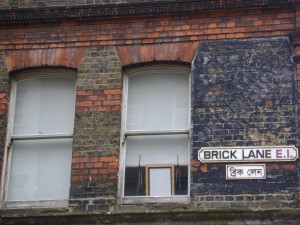 People always view progress as a positive thing, because, it means improvement for a community that means it. What I have learned being in London, is that progress has the potential to be something great, but at the expense of who? Professor Qualls has made me realize these past few days, is that the concept of progress is something beneficial, to a specific group, but at the expense of who? In order for true progress to be made a specific group must pay. Looking at the east end, it is obvious that the area is becoming economically improved, but at the expense of the middle and working classes in the area. The area is beginning to see major improvements, in both the markets and financial district, but the lower classes are taking a beating, because soon they will not be able to afford the area in which they live, and will be forced to move out. In essence this is progress in its truest form. However, it felt surreal to be in an area in which we have read so much about, and viewing the drastic changes in the area, gave me a sense of joy, but this emotion was balanced with a sense of sadness because of the effects this had on the community.
People always view progress as a positive thing, because, it means improvement for a community that means it. What I have learned being in London, is that progress has the potential to be something great, but at the expense of who? Professor Qualls has made me realize these past few days, is that the concept of progress is something beneficial, to a specific group, but at the expense of who? In order for true progress to be made a specific group must pay. Looking at the east end, it is obvious that the area is becoming economically improved, but at the expense of the middle and working classes in the area. The area is beginning to see major improvements, in both the markets and financial district, but the lower classes are taking a beating, because soon they will not be able to afford the area in which they live, and will be forced to move out. In essence this is progress in its truest form. However, it felt surreal to be in an area in which we have read so much about, and viewing the drastic changes in the area, gave me a sense of joy, but this emotion was balanced with a sense of sadness because of the effects this had on the community.
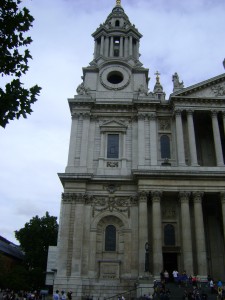 We later travelled to St. Pauls’ lead by our fabulous tour guide John. John was our tour guide for the West Minster Abbey, and because he did such an amazing job, professor Qualls decided John was more than capable to lead us in this national land mark of London. Once we all had arrived John began speaking about the birth of the St. Pauls’ Cathedral and the route and the history of its name. One thing Jon said before entering that I didn’t agree with was when he said, “be mindful that this place is still a church so please be mindful.” Once I entered St. Paul’s cathedral, I immediately noticed the outrageous fee to enter this “church.” I could not help but see this ever apparent contradiction, in that museum cost money, and churches are supposed to be free. Not only that but the electronic tour guides, and the amount of people who just seemed interested in looking at its architecture rather than praising god could have not convinced me more, that this Cathedral had lost its “holiness” a long time ago, at least in my opinion. My perceptions of St. Paul as a tourist attraction, however, were nothing but positive. The architecture was beautiful, and its history was astounding. As I climbed the steps of St. Pauls’ I could not help but think that in the immediate future I would be on the top of the city.
We later travelled to St. Pauls’ lead by our fabulous tour guide John. John was our tour guide for the West Minster Abbey, and because he did such an amazing job, professor Qualls decided John was more than capable to lead us in this national land mark of London. Once we all had arrived John began speaking about the birth of the St. Pauls’ Cathedral and the route and the history of its name. One thing Jon said before entering that I didn’t agree with was when he said, “be mindful that this place is still a church so please be mindful.” Once I entered St. Paul’s cathedral, I immediately noticed the outrageous fee to enter this “church.” I could not help but see this ever apparent contradiction, in that museum cost money, and churches are supposed to be free. Not only that but the electronic tour guides, and the amount of people who just seemed interested in looking at its architecture rather than praising god could have not convinced me more, that this Cathedral had lost its “holiness” a long time ago, at least in my opinion. My perceptions of St. Paul as a tourist attraction, however, were nothing but positive. The architecture was beautiful, and its history was astounding. As I climbed the steps of St. Pauls’ I could not help but think that in the immediate future I would be on the top of the city.
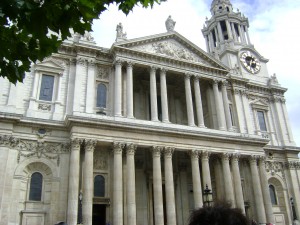 Once I arrived the scenery was amazingly beautiful, I had never seen such an astounding sight. I was able to view London from an entirely different vantage point, and in doing so, I realized the true beauty of this chaotic city. I realized that, London, was the only city I have ever been to that had such an interesting personality, from the people, to its appearance, its multifaceted diversity was something that out of a book. It was something I will not soon forget!!!
Once I arrived the scenery was amazingly beautiful, I had never seen such an astounding sight. I was able to view London from an entirely different vantage point, and in doing so, I realized the true beauty of this chaotic city. I realized that, London, was the only city I have ever been to that had such an interesting personality, from the people, to its appearance, its multifaceted diversity was something that out of a book. It was something I will not soon forget!!!
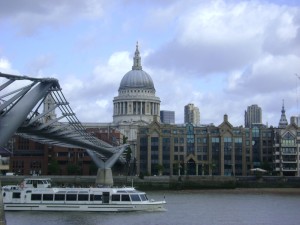
Tags: Anthony
September 5th, 2009 · 2 Comments
-
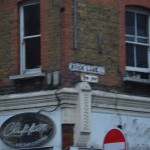
-
Brick Lane
-

-
Each Religion Can Be Beautiful in Its Own Right
On Wednesday our entire class went on a walk of London’s East End. After reading a few books this Summer dealing with this part of the city I had a very narrow view of what to expect before going on the tour. The East End is typically home to the most recent immigrant population of London which today is the large Bangladeshi community that has immigrated within the past 30 years. Most of the post colonial literature we read portrayed the east end and specifically Brick Lane as a dingy place where its inhabitants are trapped between their home culture and the culture of Great Britain. Often this leads to conflict and not the best living situation.
After hearing all of this negative portrayal of the East End I was surprised once we got away from Liverpool Street Station to see a quiet, unobtrusive Brick Lane. Part of this could have been attributed to Ramadan taking place which nearly all of the East End Bangladeshis observe. That being said it was evident a lot had changed in Brick Lane over the past few years. It was noticable that the city had been putting in a strong effort to change the dynamic of the area. As we concluded our walk and moved into a more well-off area near the Tower of London I realized that the image I had of the East End going into the tour was not close to what I had found. In fact the only thing that reminded me of the East End I read about was when I was riding west on the Central Line later that afternoon from Mile End to Bank and I noticed an incredible difference in the overall quality of the two Underground Stations. When hearing about Brick Lane I had expected something more akin to East St. Louis but instead found something closer to East Dublin or East Carlisle. Sarah made a great point in class today that the Brick Lane area seemed to have a bit of a “hipster” feel to it. To go along with this you’ll notice one of my hyperlinks above is connected to a series of restaurants on Brick Lane. Ten and maybe even five years ago this would never have happened. Although there were signs of immigrant communities in Brick Lane they did not become extremely noticeable until we got to the Whitechapel area. If Brick Lane is indeed becoming an area where the London mainstream is beginning to spend a good amount of time and money then where are the first generation immigrants being pushed to?
On Thursday we got to observe another area of London where immigration was prevalent as we headed to Southall, home to a large Indian community. Unlike the East End my first impression of Southall was just what I expected it to be. Walking through the area I noticed a very diverse Indian community consisting of people dressed both in western attire and in traditional south Asian clothing. Along the walk I noticed a few Churches which told me that the community has assimilated into the greater British culture a little bit. After a few more minutes of exploration we arrived outside the Gurdwara Sri Guru Singh Sabha, put scarves over our heads and prepared to head inside. Upon entering the first thing I noticed were the separate areas for men and women to hand over their shoes and cleanse themselves before prayer. The only experience I had to compare this to was when I visited a mosque many years ago and the same process took place. As we entered the main hall and waited to begin our tour I took in my surroundings. There was a man writing Punjabi on a whiteboard and a collection of men women and children wandering throughout, praying and meditating but most of all staring at the group of 28 Americans standing in the middle of the Gurdwara. Eventually our guide Mr. Singh showed up and began to tell us all about the Gurdwara and about Sikhism. The main things that I gained and understood from his quiet, pensive voice is that Sikhism is a religion of love and a religion in which learning takes place throughout one’s entire life. No Sikh has all of the knowledge in the world and each member of the community has the ability to learn from each other and from God. Mr. Singh was a very humble man and spent a lot of time continually apologizing to us that he was not a worthy guide. I sensed that humbleness is a quality found often within the Sikh religion. Although I felt slightly uncomfortable walking into the prayer room, bowing to the guru and heading back out I enjoyed my experience at the Gurdwara overall. The visit was capped off by a wonderful meal that was simple but nourishing, a metaphor of the Sikh religion as a whole.
On Friday as our class discussed the post-colonial literature we read I tried to find connections between our experience at the Gurdwara and the stories we read about. None of the books we read featured a major Sikh character so it was hard to make a direct comparison. However, one thing that I noticed that seems to apply to all immigrant groups is that there are stark differences in how the first generation and second generation handle themselves in the community. In just about every immigrant population we’ve read about/observed here in London the first generation immigrants tend to want to hold on to their home culture/religion whereas the children of first generation immigrants try to fit in with the greater British culture a bit more. This only makes sense considering the majority of them are attending public schools with other children from different backgrounds and have no experience living in the place where their parents are from. I noticed in the Gurdwara that many of the children were dressed in more western garb and wore a dew-rag type of head covering instead of a traditional scarf. Also I did not see anyone at the Gurdwara that was a teenager. It seems to me that England is very similar to the U.S. in that religion is lost on a lot of young people. I’m curious to find out if this is true throughout the world.
Overall my readings of Post-Colonial literature and my visit to the Gurdwara taught me a number of things. The first is that it is impossible to predict exactly how an immigrant group will assimilate or whether they will at all. It is also difficult to predict how each generation will handle being in a new situation. Despite these unanswered questions I learned a lot from the books we read and through our visit to the Gurdwara. I know that this learning will continue as I spend more and more time in London and as I move on throughout life. Much like the Sikh religion, learning about immigration is a lifelong task.
Tags: Henry
Today’s walk to the East End was a new and different experience for me. Having grown up in a middle class, white, rural area it was wonderful to actually see the complete opposite of the area in which I grew up. As much as I love ethnic street fairs and pan-asian food I had never really seen an area so completely different from the one I am used to.
When I read Salaam, Brick Lane I had problems envisioning the actual street. As much as I enjoyed the book I still was picturing more of a slum than a habitable living area (Jack London’s quotes about murder and refuse didn’t help). Indeed, when the book was written things were much worse in that area than they are now, but it was still quite helpful for me to actually see the setting.
What struck me most was that even though the Gherkin could still be seen over the tops of the buildings, it actually felt like we were in a completely different city. Sadly most of the shops were closed due to Ramadan, but it is definitely a place I want to explore further.
However, it was surprising to see just how much it had changed since Mr. Hall wrote his book. From what he described I assumed Brick Lane to be little more than a slum. While not exactly the nicest neighborhood it was far from unpleasant. From the number of people in their mid-twenties that I saw wandering around it seems as though the area is an up-and-coming place. This is just another example of the ever changing demographic in this section of London. Instead of a new group of immigrants it seems to me that perhaps the next tenants will be young adults looking for their first apartment. From what I saw today I wouldn’t mind living there myself.
In contrast, this afternoon we took a tour of St. Paul’s Cathedral. It was quite a stark difference going from the rather poorer East End to the opulence of Christopher Wren’s masterpiece. While the entire tour was interesting, the highlight was definitely the trek up the dome. The view from the top was breathtaking. We were treated to a view of the whole of London spread out beneath us, and as segregated as parts of London are on the ground, from up that high there are no boundaries drawn between sections of the city. It is all just one big sprawling mass and there are no distinctions. It was a nice change from the racism we have been discussing during class.
It was a good day and I’d love to explore the East End further.
Tags: Campbell
August 24th, 2009 · 1 Comment
I would be lying if I said that I was unaffected by the slavery exhibit at the Dockland Museum. I would also be lying if I said that I expected such a reaction. I realize that the types of heinous treatments and horrific events (as depicted in this museum) are all in the past, but imagining how the enslaved Africans must have felt bothered me immensely. In particular, I saw a painting of six Africans enduring six types of torturous punishments (filed teeth and an iron neck brace, for example), each with a gruesome smile. I was disturbed by their expressions and the way that the artist depicted these people. The image, to me, is utterly haunting.
A group of students and I also watched a short video with images and phrases meant to help the viewer better empathize with how the enslaved Africans must have felt. Describing being away from one’s family, having one’s name changed, and being forced to learn a new language and set of customs were included in this portrayal. I could not help but think of Nanzeen, the main character in Brick Lane. Although her situation was entirely different, many of the ways she felt in the novel were the same. Learning to adapt to an English lifestyle after loving her childhood in Bangladesh seemed to have taken an exceedingly negative toll on Nanzeen’s psyche. I was appalled by that; how much worse, then, would I feel if I fully understood the impact that slavery had on the Africans? I was also a bit put-off by a poster showing a picture of Oleaudah Equiano (or Gustavo Vassa), who wrote The Interesting Narrative of the Life of Oleaudah Equiano. He describes his experience in becoming a freed man and moving to London to make a name for himself as both a hairdresser and musician. In the museum’s representation, he is shown as a hero who worked hard to fight against the slave trade. In reality, though, Equiano recounts instances of him actually working as a part of the slave trade. For a period of time, in fact, he was an overseer on a plantation and reports mistreating other slaves. During these events he had already been freed, and thus could have chosen not to act in such a manner. I feel that, although he may have done good things for the African enslaved community, he also stooped to the level of those who formerly oppressed him. I do not think that this should have been overlooked.
Finally, I was moved by a quote from The Negro’s Complaint, written by William Cowper, stating: “Men from England bought and sold me,/Paid my price in palry gold:/But, though theirs they have enroll’d me/Minds are never to be sold.” I can’t pinpoint exactly why I liked the quote, but I did want to share it regardless.
Tags: Amy





 People always view progress as a positive thing, because, it means improvement for a community that means it. What I have learned being in London, is that progress has the potential to be something great, but at the expense of who? Professor Qualls has made me realize these past few days, is that the concept of progress is something beneficial, to a specific group, but at the expense of who? In order for true progress to be made a specific group must pay. Looking at the east end, it is obvious that the area is becoming economically improved, but at the expense of the middle and working classes in the area. The area is beginning to see major improvements, in both the markets and financial district, but the lower classes are taking a beating, because soon they will not be able to afford the area in which they live, and will be forced to move out. In essence this is progress in its truest form. However, it felt surreal to be in an area in which we have read so much about, and viewing the drastic changes in the area, gave me a sense of joy, but this emotion was balanced with a sense of sadness because of the effects this had on the community.
People always view progress as a positive thing, because, it means improvement for a community that means it. What I have learned being in London, is that progress has the potential to be something great, but at the expense of who? Professor Qualls has made me realize these past few days, is that the concept of progress is something beneficial, to a specific group, but at the expense of who? In order for true progress to be made a specific group must pay. Looking at the east end, it is obvious that the area is becoming economically improved, but at the expense of the middle and working classes in the area. The area is beginning to see major improvements, in both the markets and financial district, but the lower classes are taking a beating, because soon they will not be able to afford the area in which they live, and will be forced to move out. In essence this is progress in its truest form. However, it felt surreal to be in an area in which we have read so much about, and viewing the drastic changes in the area, gave me a sense of joy, but this emotion was balanced with a sense of sadness because of the effects this had on the community. We later travelled to St. Pauls’ lead by our fabulous tour guide John. John was our tour guide for the West Minster Abbey, and because he did such an amazing job, professor Qualls decided John was more than capable to lead us in this national land mark of London. Once we all had arrived John began speaking about the birth of the St. Pauls’ Cathedral and the route and the history of its name. One thing Jon said before entering that I didn’t agree with was when he said, “be mindful that this place is still a church so please be mindful.” Once I entered St. Paul’s cathedral, I immediately noticed the outrageous fee to enter this “church.” I could not help but see this ever apparent contradiction, in that museum cost money, and churches are supposed to be free. Not only that but the electronic tour guides, and the amount of people who just seemed interested in looking at its architecture rather than praising god could have not convinced me more, that this Cathedral had lost its “holiness” a long time ago, at least in my opinion. My perceptions of St. Paul as a tourist attraction, however, were nothing but positive. The architecture was beautiful, and its history was astounding. As I climbed the steps of St. Pauls’ I could not help but think that in the immediate future I would be on the top of the city.
We later travelled to St. Pauls’ lead by our fabulous tour guide John. John was our tour guide for the West Minster Abbey, and because he did such an amazing job, professor Qualls decided John was more than capable to lead us in this national land mark of London. Once we all had arrived John began speaking about the birth of the St. Pauls’ Cathedral and the route and the history of its name. One thing Jon said before entering that I didn’t agree with was when he said, “be mindful that this place is still a church so please be mindful.” Once I entered St. Paul’s cathedral, I immediately noticed the outrageous fee to enter this “church.” I could not help but see this ever apparent contradiction, in that museum cost money, and churches are supposed to be free. Not only that but the electronic tour guides, and the amount of people who just seemed interested in looking at its architecture rather than praising god could have not convinced me more, that this Cathedral had lost its “holiness” a long time ago, at least in my opinion. My perceptions of St. Paul as a tourist attraction, however, were nothing but positive. The architecture was beautiful, and its history was astounding. As I climbed the steps of St. Pauls’ I could not help but think that in the immediate future I would be on the top of the city. Once I arrived the scenery was amazingly beautiful, I had never seen such an astounding sight. I was able to view London from an entirely different vantage point, and in doing so, I realized the true beauty of this chaotic city. I realized that, London, was the only city I have ever been to that had such an interesting personality, from the people, to its appearance, its multifaceted diversity was something that out of a book. It was something I will not soon forget!!!
Once I arrived the scenery was amazingly beautiful, I had never seen such an astounding sight. I was able to view London from an entirely different vantage point, and in doing so, I realized the true beauty of this chaotic city. I realized that, London, was the only city I have ever been to that had such an interesting personality, from the people, to its appearance, its multifaceted diversity was something that out of a book. It was something I will not soon forget!!!


